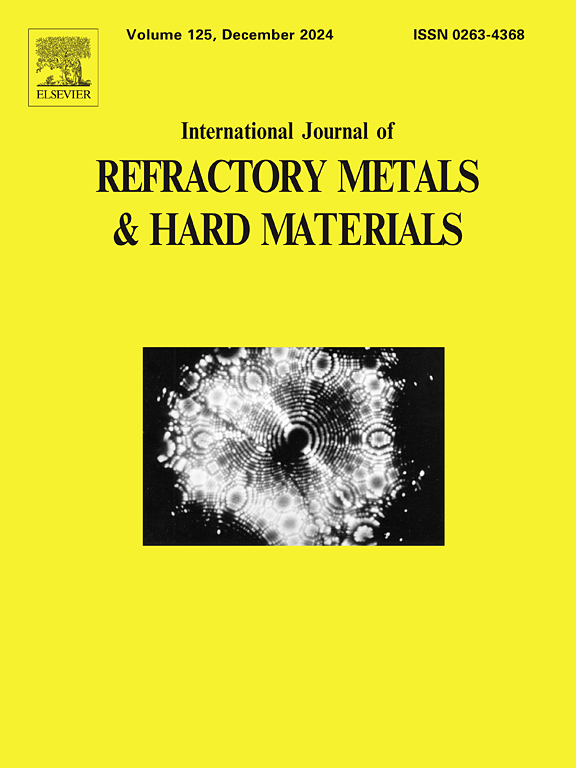化学镀镍碳化钨粉末材料选择性激光熔化刀具的研制
IF 4.2
2区 材料科学
Q2 MATERIALS SCIENCE, MULTIDISCIPLINARY
International Journal of Refractory Metals & Hard Materials
Pub Date : 2025-03-29
DOI:10.1016/j.ijrmhm.2025.107169
引用次数: 0
摘要
这项研究是关于是否可以使用更便宜和更容易获得的Ni粘结剂来生产硬质合金工具,而不是使用选择性激光熔化的昂贵的Co粘结剂,这是一种新一代的生产方法,可以很容易地在期望的设计中生产而不会损失废料。采用选择性激光熔化(SLM)法确定了化学沉积镀镍WC粉末的最佳激光加工参数,并根据这些参数生产了车削刀片。基于slm的车削刀片,包括镀镍WC粉(WC- ni)的生产,由于缺乏粘结剂而遇到了一些问题。将纯Ni粉末添加到Ni包覆WC粉末(WC-Ni + Ni)中,以改善结合,增加相对密度,降低表面粗糙度,使磨损率降低约95%。在最佳SLM条件下,测得的显微硬度值为1879±130 HV0.3。然后对SLM生产的车削刀片表面进行磨削。采用TiN涂层,涂层后显微硬度为2002±174 HV0.3。车削后,镀锡SLM刀片的表面磨损最小,性能与传统制造的刀片非常接近。本文章由计算机程序翻译,如有差异,请以英文原文为准。

Development of cutting tools with selective laser melting from electroless nickel-coated tungsten carbide powder material
This study was on whether cemented carbide tools could be produced using cheaper and more readily available Ni binder instead of expensive Co binder using selective laser melting, which is a new generation production method that can be easily produced in the desired design without losing scrap. The study determined the optimum laser manufacturing parameters for the production of Ni coated WC powder by electroless deposition using the selective laser melting (SLM) method and produced turning inserts with those parameters. Production of SLM-based turning inserts, including Ni-coated WC powder (WC-Ni), encountered some problems due to lack of binder. Pure Ni powders were added to Ni-coated WC powders (WC-Ni + Ni) to improve bonding which increased relative density, reduced surface roughness and resulted in ∼95 % reduced wear rate. For optimum SLM conditions, the microhardness value was measured as 1879 ± 130 HV0.3. The surfaces of the turning inserts produced by SLM were then ground. TiN coating was applied and the microhardness after coating was as 2002 ± 174 HV0.3. After turning, the TiN-coated SLM insert had the lowest surface wear and performed very close to the conventionally manufactured insert.
求助全文
通过发布文献求助,成功后即可免费获取论文全文。
去求助
来源期刊
CiteScore
7.00
自引率
13.90%
发文量
236
审稿时长
35 days
期刊介绍:
The International Journal of Refractory Metals and Hard Materials (IJRMHM) publishes original research articles concerned with all aspects of refractory metals and hard materials. Refractory metals are defined as metals with melting points higher than 1800 °C. These are tungsten, molybdenum, chromium, tantalum, niobium, hafnium, and rhenium, as well as many compounds and alloys based thereupon. Hard materials that are included in the scope of this journal are defined as materials with hardness values higher than 1000 kg/mm2, primarily intended for applications as manufacturing tools or wear resistant components in mechanical systems. Thus they encompass carbides, nitrides and borides of metals, and related compounds. A special focus of this journal is put on the family of hardmetals, which is also known as cemented tungsten carbide, and cermets which are based on titanium carbide and carbonitrides with or without a metal binder. Ceramics and superhard materials including diamond and cubic boron nitride may also be accepted provided the subject material is presented as hard materials as defined above.

 求助内容:
求助内容: 应助结果提醒方式:
应助结果提醒方式:


